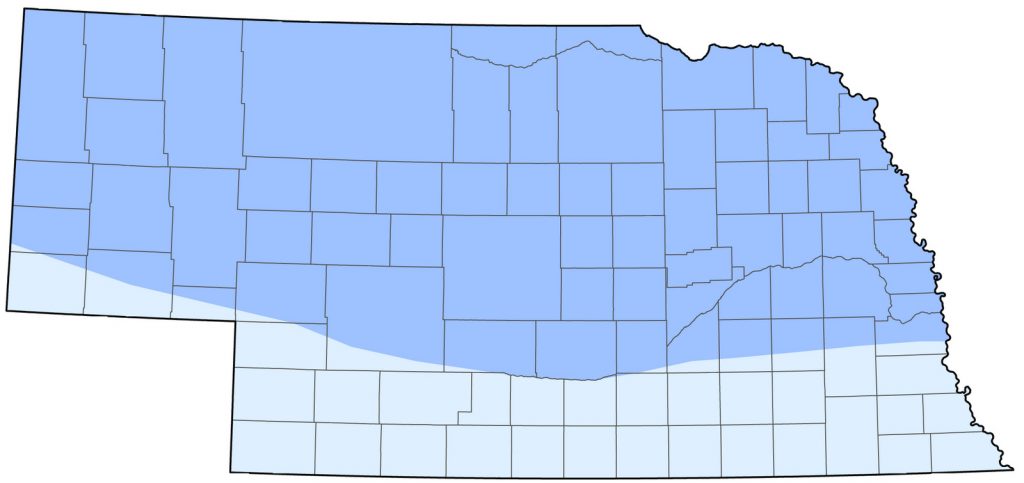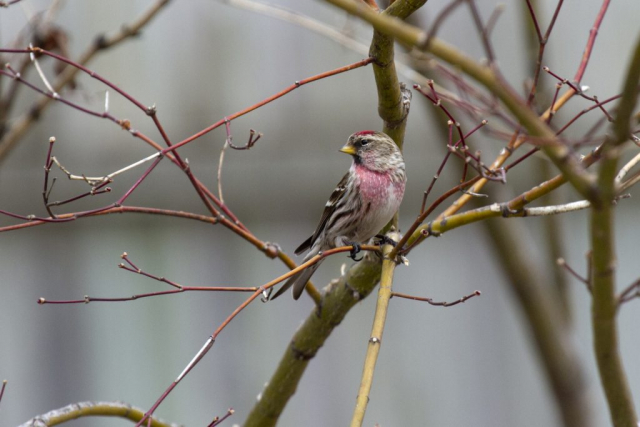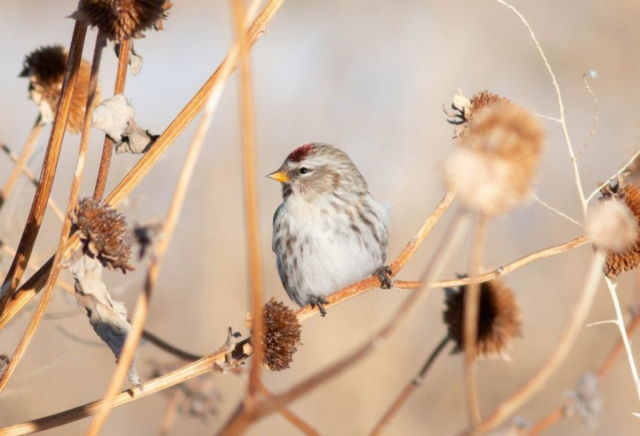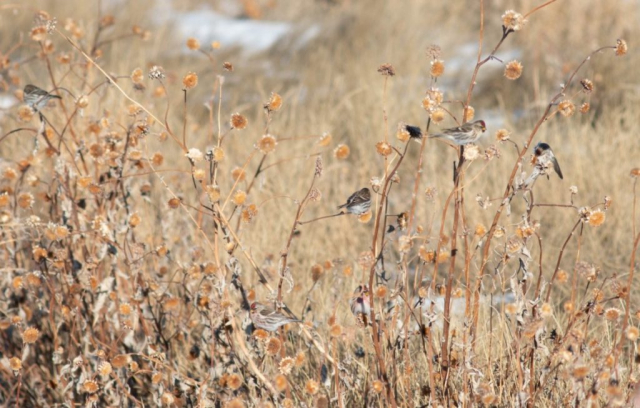Acanthis flammea
Status: Uncommon regular winter visitor north, east, and west, rare south.

Documentation: Specimen: UNSM ZM7139, 11 Dec 1895 Crawford, Dawes Co.
Taxonomy: Five subspecies are recognized (AviList 2025), flammea of northern Eurasia and northern North America, rostrata of northeastern Canada, Greenland, and Iceland, wintering northeastern US and British Isles, cabaret recently expanding into most of Europe from the British Isles and introduced to New Zealand, exilipes of the tundra of northern Eurasia and northern North America, and hornemanni, breeding Ellesmere and Baffin islands and northern Greenland, wintering to northern US and British Isles.
These subspecies were traditionally treated as three species, Common Redpoll (flammea, rostrata), Lesser Redpoll (cabaret), and Hoary Redpoll (exilipes, hornemanni), but mitochondrial, nuclear, and genomic analyses showing a lack of divergence and high levels of gene flow (Marthinsen et al 2008; Mason and Taylor 2015) resulted in the three former species being merged into one, Redpoll A. flammea with five subspecies (Chesser et al 2024). Phenotypic variation in the redpolls was shown by Funk et al (2021) to result from a significant chromosomal inversion, common to all redpoll forms, controlling expression of phenotype characters through “environmental selection”. As noted by AviList (2025), however, there is “evidence of assortative mating where the taxa come into secondary contact, and the three taxa are generally identifiable as discrete phenotypes; further research needed.”
The widespread North American subspecies flammea (former Common Redpoll) occurs regularly in Nebraska (Rapp et al 1958).
The larger northeastern taxon rostrata, breeding in Greenland and Baffin Island, is said to have occurred casually in winter to Colorado and Iowa (AOU 1957, DuMont 1934) but is undocumented in Nebraska. eBird.org (accessed Dec 2023) shows no reports of rostrata southwest of the Great Lakes; perhaps earlier records were using now outdated taxonomic concepts.
There had been about 15 reports of “Hoary Redpoll” for Nebraska prior to its 2024 lumping with Redpoll. Only four of these were submitted to NOURC, one of which was accepted (Brogie 2022), one photographed 3 Dec 2021 in Sioux Co (Steven Mlodinow, eBird Checklist – 3 Dec 2021). Bray et al (1986) accepted four of five reports that occurred prior to establishment of NOURC in 1986.
Winter: Oct 24, 24, 24 <<<>>> Mar 29, 29, 30
In years when Redpolls are present, arrival is in late Oct, although an earlier date is 7 Oct 1987 Knox/Antelope Cos, when 20 were seen (Williams 1988, eBird.org).
Later dates are 2 Apr 2015 Scotts Bluff Co, 15 Apr 2018 Dawes Co, and 23 Apr 2018 Seward Co.
CBC data show that most Redpolls are in northern and western Nebraska in late Dec. In winter 2021-2022, the distribution of Redpolls across the state was split, with moderate numbers in the northeast, none in the central, and much higher numbers in the west, especially in Dec, where best counts were an impressive 205 at Wind Springs Ranch, Sioux Co 3 Dec and 135 on Toadstool Road, Sioux Co 18 Dec whereas in the east, the only double-digit count was 11 near Newcastle, Dixon Co 5 Feb.
High CBC counts are 303 at Crawford 1977-78, 239 at DeSoto NWR 29 Dec 2012, 230 at Greeley 1969-70 and 176 at Calamus-Loup 31 Dec 2012. None were reported on CBCs in about a third of the years since 1966. The largest CBC peak in terms of birds per party-hour was 1977-1978 with 0.96 and 309 counted; the 2012-2013 influx reached 0.58 with 272 counted.
- High counts: 800 in Dawes Co 18 Mar 1978 (Williams 1978), 400 in Holt Co 1 Mar 1973 (Williams 1972), 350 in Cherry Co 8 Mar 2013, and “several hundred” in Boone Co 3-6 Feb 1982 (Williams 1982).
- The major incursion of 2012-2013 had about 1500 birds reported statewide.
Comments:
Images
Abbreviations
AOU: American Ornithologists’ Union
CBC: Christmas Bird Count
NOURC: Nebraska Ornithologists’ Union Records Committee
NWR: National Wildlife Refuge
UNSM: University of Nebraska State Museum
Literature Cited
American Ornithologists’ Union [AOU]. 1957. The AOU Check-list of North American birds, 5th ed. Port City Press, Baltimore, Maryland, USA.
American Ornithologists’ Union [AOU]. 2016. AOU Classification Committee – North and Middle America Proposal Set 2016-A 10 Nov 2015.
AviList Core Team, 2025. AviList: The Global Avian Checklist, v2025. https://doi.org/10.2173/avilist.v2025.
Bray, T.E., B.K. Padelford, and W.R. Silcock. 1986. The birds of Nebraska: A critically evaluated list. Published by the authors, Bellevue, Nebraska, USA.
Brogie, M.A. 2022. 2021 (33rd) Report of the NOU Records Committee. NBR 90: 113-122.
Chesser, R.T., S.M. Billerman, K.J. Burns, C. Cicero, J.L. Dunn, B.E. Hernandez-Banos, R.A. Jimenez, O. Johnson, A.W. Kratter, N.A. Mason, P.C. Rasmussen, and J. V. Remsen, Jr. 2024. Sixty-fifth Supplement to the American Ornithologists’ Union Check-list of North American Birds. Ornithology 141. https://doi.org/10.1093/ornithology/ukae019.
DuMont, P.A. 1934. A revised list of the birds of Iowa. Studies in Natural History 15 (5), University of Iowa Studies, Iowa City, Iowa, USA.
Funk, E.R., N.A. Mason, S. Pálsson, T. Albrecht, J.A. Johnson, and S.A. Taylor. 2021. A supergene underlies linked variation in color and morphology in a Holarctic songbird. Nature Communications 12. DOI: 10.1038/s41467-021-27173-z
Knox, A.G. and P.E. Lowther. 2020. Common Redpoll (Acanthis flammea), version 1.0. In Birds of the World (S. M. Billerman, Editor). Cornell Lab of Ornithology, Ithaca, NY, USA. https://doi.org/10.2173/bow.comred.01.
Marthinsen, G., L. Wennerberg, and J.T. Lifjeld. 2008. Low support for separate species within the redpoll complex (Carduelis flammea-hornemanni-cabaret) from analyses of mtDNA and microsatellite markers. Molecular Phylogenetics and Evolution 47:1005–1017.
Mason, N.A., and S.A. Taylor. 2015. Differentially expressed genes match bill morphology and plumage despite largely undifferentiated genomes in a Holarctic songbird. Molecular Ecology 24: 3009–3025.
Rapp, W.F. Jr., J.L.C. Rapp, H.E. Baumgarten, and R.A. Moser. 1958. Revised checklist of Nebraska birds. Occasional Papers 5, Nebraska Ornithologists’ Union, Crete, Nebraska, USA.
Williams, F. 1972. Southern Great Plains Region. American Birds 26: 624-626.
Williams, F. 1978. Southern Great Plains Region. American Birds 32: 1024-1028.
Williams, F. 1982. Southern Great Plains Region. American Birds 36: 307-309.
Williams, F. 1988. Southern Great Plains Region. American Birds 42: 96-100.
Recommended Citation
Silcock, W.R., and J.G. Jorgensen. 2025. Redpoll (Acanthis flammea). In Birds of Nebraska — Online. www.BirdsofNebraska.org
Birds of Nebraska – Online
Updated 21 Jul 2025



